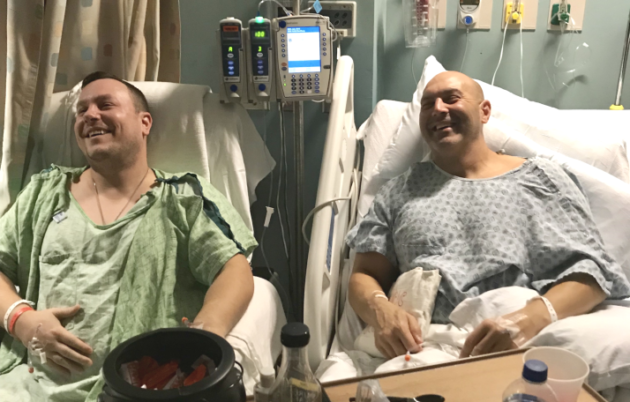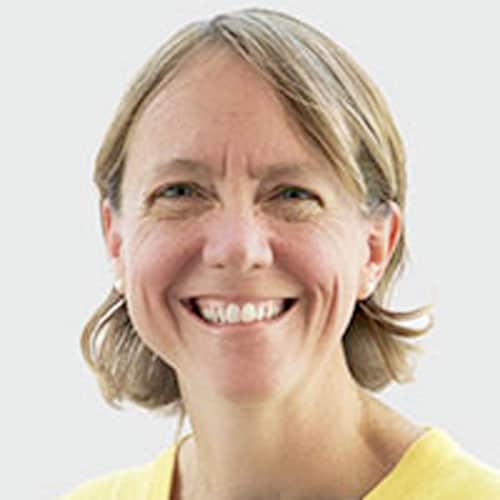December 2019 update: Lieutenant Schermerhorn and Officer Wlosinski both continue to do extremely well following the successful October 2018 kidney transplant procedure at the University of Rochester Medical Center. Both gentlemen are still officers in the Department of Public Safety, and recently celebrated the anniversary of the kidney donation.
For the past two years, Lieutenant Dan Schermerhorn Jr. has undergone dialysis for eight hours, each night while he sleeps, to treat his kidney disease, IgA nephropathy. An officer with the University’s Department of Public Safety (DPS) for 23 years, Schermerhorn had dealt with this disease for 15 years, until doctors at UR Medicine’s Strong Memorial Hospital told him he needed a new kidney to save his life.
“Replacing a damaged kidney like mine with a new one is like putting new batteries into your flashlight when it’s starting to die, and then you’re back to fully functioning again,” says Schermerhorn. “There’s no more fatigue or dialysis.” A successful transplant returns Schermerhorn to the activities he’s passionate about, but that were restricted by his illness—running, swimming, competing in triathlons, traveling, and spending quality time with his family.
Schermerhorn’s search for a new kidney began in 2016 when he was placed on the kidney transplant waiting list, and he also joined the National Kidney Registry, a non-profit network that aims to match thousands of individuals in need with a compatible, willing donor. Compatibility doesn’t come easily; Schermerhorn’s father tried to be a donor to his son, but after being evaluated for a match, found he was not compatible.
In October 2017, Lieutenant Keri Stein sent an email to the entire Department of Public Safety (about 140 staff members), explaining Schermerhorn’s condition and the living donor process. Several colleagues responded by making appointments to be evaluated as possible matches. Willing donors are first checked to see that their blood and tissue types are compatible with the recipient’s, and that the recipient’s antibodies won’t fight against the donated organ. From there, they are evaluated on whether they are healthy enough to give a kidney, that their kidneys are currently working well, and that they are mentally prepared for the donation.
Peace Officer Paul Wlosinski remembers seeing the email from Stein.
“I always have in my mind, ‘never go through life saying you could have done something,’” Wlosinski says.
Wlosinski is an officer in the first platoon who over the years has worked directly with Schermerhorn on the force. Currently, he works overnight shifts, and Schermerhorn works days as part of new officer training and compliance certification programs. Wlosinski made an appointment to be evaluated as a match, and through the subsequent lab results and examinations learned that he could be a compatible and healthy kidney donor to Schermerhorn.
One day this past spring, when the two officers overlapped at work, Wlosinski told Schermerhorn that he was being evaluated as a potential donor. In the months that followed, two separate teams of physicians, transplant coordinators, social workers, and others from the Division of Solid Organ Transplant at the University of Rochester Medical Center—one team solely overseeing the care for Schermerhorn, and one caring only for Wlosinski—determined that everything was looking good to move forward with a transplant this fall.
“For me, it’s a second chance,” says Schermerhorn. “We’re like a band of brothers working here, and there’s a responsibility for him to watch my back, and I watch his. You just build that relationship. That’s how I feel now—it’s like he’s my backup. There’s a lot of things in my life that he’s impacting by doing this, and I’m very grateful for it.”
“It’s just something I want to do,” says Wlosinski, who is also a US Army veteran. “I’m just glad that I’m able to do something. I knew I had to get tested because I can. The donation of my kidney isn’t going to affect me in such great a fashion that I can’t. So, I can and I should.”
“Paul’s heart amazes me in its compassion and conviction, the things that drive him to do things such as donating a kidney,” says Laura Wlosinski, Paul’s wife and an emergency dispatcher for DPS. “When we first discussed Paul getting tested, it was in great depth about what that meant for him personally and for our family going forward. He has been committed from the start and knew that if he was a match he would go through with the donation. He said to me before the initial test, ‘I don’t want to know that I potentially could have helped Dan and never tried. I can’t live with that.’ I think that accurately speaks volumes to who he is and is a great example of the way he lives.”
On October 30, 2018, the Medical Center’s transplant team, led by Jeremy C. Taylor, associate director of transplant nephrology, and surgeons Mark S. Orloff and Koji Tomiyama successfully performed the transplant procedure. Both Schermerhorn and Wlosinski are recuperating well.
“After 36 years in law enforcement, I am always amazed how willing brother and sister officers are to sacrifice for each other,” says Public Safety Chief Mark Fischer. “Paul’s actions have touched my entire department, and will forever impact the life of Dan and his family. It’s truly inspirational.”
Living Donation Program at URMC
Rochester’s Division of Solid Organ Transplant cares for patients from across upstate New York and northern Pennsylvania, offering kidney, liver, and pancreas transplants, as well as a pediatric liver transplant program. A significant focus is on living-donor kidney and liver transplants, supported by the recruitment of additional transplant surgeons, nephrologists and hepatologists, and other staff.

The Medical Center is the top provider of live-donor kidney transplants in upstate New York. The number of kidney transplants in the first seven months of 2018 surpassed the total number performed in 2017, with just over 40 percent now a result of living donors.
“We encourage our patients to consider living donation whenever possible,” says surgeon Roberto Hernandez-Alejandro, division chief of Solid Organ Transplant. “Heroes like Peace Officer Wlosinski selflessly provide the gift of life, which can translate into better recovery and long-term survival for Lieutenant Schermerhorn and patients just like him.”
The transplant team also offers a paired kidney exchange program, which connects the Medical Center to a consortium of academic medical centers across the country. It allows living-donor kidney donors who are not a match for a known recipient, but are still willing to donate, to give a kidney to a stranger in need of transplant, and in turn their loved one receives an organ from a similar donor.



